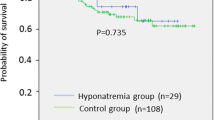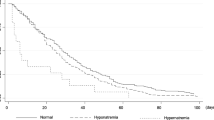Abstract
Background
During chemotherapy, hyponatremia is one of the most frequently encountered adverse effects. This study aimed to investigate the prognostic impact of hyponatremia induced by systemic chemotherapy (HIC) using a propensity matching method in cumulative pooled data.
Methods
Between January 2011 and July 2017, 2129 patients were administered systemic chemotherapy for malignancy in various organs at Nagoya City University Hospital. Patients were divided into two groups: a grade 0–1 group (control group) and a grade 3–4 group (severe group) according to the severity of HIC appearing within 30 days after starting treatment. Kaplan–Meier curves were used for survival and recurrence analyses using a propensity case-matched analysis.
Result
The number of severe HIC patients was 93 (4.4%). In platinum-containing regimens, HIC appeared at higher frequencies. In the 21.2 months median follow-up period, the median OS (mOS) in the severe group was 49.1 months, which was significantly worse than the mOS in the control group; the OS in the control group did not reach the median. Univariate and multivariate analyses of associated factors in patients with grade 3–4 HIC revealed that renal dysfunction, cisplatin-containing regimen, and infusion of more than 5000 mL fluid was associated with HIC.
Conclusion
This study suggests that severe HIC in the first treatment cycle affects survival time. Chemotherapy patients receiving extensive hydration should be required to undergo frequent monitoring of serum sodium levels, especially patients receiving platinum-containing regimens.



Similar content being viewed by others
References
Hori M, Matsuda T, Shibata C et al (2009) Cancer incidence and incidence rates in Japan in 2009: a study of 32 population-based cancer registries for the Monitoring of Cancer Incidence in Japan (MCIJ) project. Jpn J Clin Oncol. 2015(45):884–891
Thompson C, Hoorn EJ (2012) Hyponatraemia: an overview of frequency, clinical presentation and complications. Best Pract Res Clin Endocrinol Metab 26(Suppl 1):S1–6
Adrogue HJ, Madias NE (2000) Hyponatremia. N Engl J Med. 342:1581–1589
Spasovski G, Vanholder R, Allolio B et al (2014) Clinical practice guideline on diagnosis and treatment of hyponatraemia. Intensive Care Med 40:320–331
Yokoyama Y, Shigeto T, Futagami M et al (2005) Syndrome of inappropriate secretion of anti-diuretic hormone following carboplatin-paclitaxel administration in a patient with recurrent ovarian cancer. Eur J Gynaecol Oncol 26:531–532
Sterns RH (2015) Disorders of plasma sodium–causes, consequences, and correction. N Engl J Med 372:55–65
Sugiyama Y, Naiki T, Kondo M et al (2017) Syndrome of inappropriate secretion of antidiuretic hormone caused by carboplatin after switching from cisplatin in a metastatic urethral cancer patient. Urol Case Rep 12:17–19
Dhaliwal HS, Rohatiner AZ, Gregory W et al (1993) Combination chemotherapy for intermediate and high grade non-Hodgkin's lymphoma. Br J Cancer 68:767–774
Tokunaga K, Matsuzawa Y, Kotani K et al (1991) Ideal body weight estimated from the body mass index with the lowest morbidity. Int J Obes 15:1–5
Kanda Y (2013) Investigation of the freely available easy-to-use software 'EZR' for medical statistics. Bone Marrow Transplant 48:452–458
Shrotriya S, Walsh D, Bennani-Baiti N et al (2015) C-reactive protein is an important biomarker for prognosis tumor recurrence and treatment response in adult solid tumors: a systematic review. PLoS O ne 10:e0143080
Bacha S, Sghaier A, Habibech S et al (2017) Combined C-reactive protein and neutrophil to lymphocyte ratio use predict survival innon-small-cell lung cancer. Tunis Med 95:229–235
Wang Y, Yang L, Xia L et al (2018) High C-reactive protein/albumin ratio predicts unfavorable distant metastasis-free survival in nasopharyngeal carcinoma: a propensity score-matched analysis. Cancer Manag Res 10:371–381
Chen Y, Wang Y, Shi Y et al (2017) Timing of chemotherapy-induced neutropenia predicts prognosis in metastatic colon cancer patients: a retrospective study in mFOLFOX6-treated patients. BMC Cancer 17:242
Berghmans T, Paesmans M, Body JJ (2000) A prospective study on hyponatraemia in medical cancer patients: epidemiology, aetiology and differential diagnosis. Support Care Cancer 8:192–197
Rodrigues B, Staff I, Fortunato G et al (2014) Hyponatremia in the prognosis of acute ischemic stroke. J Stroke Cerebrovasc Dis 23:850–854
Huang WY, Weng WC, Peng TI et al (2012) Association of hyponatremia in acute stroke stage with three-year mortality in patients with first-ever ischemic stroke. Cerebrovasc Dis 34:55–62
Furukawa J, Miyake H, Kusuda Y et al (2015) Hyponatremia as a powerful prognostic predictor for Japanese patients with clear cell renal cell carcinoma treated with a tyrosine kinase inhibitor. Int J Clin Oncol 20:351–357
Funk GC, Lindner G, Druml W et al (2010) Incidence and prognosis of dysnatremias present on ICU admission. Intensive Care Med 36:304–311
Ko SK, Kim SK, Share A et al (2014) Synthetic ion transporters can induce apoptosis by facilitating chloride anion transport into cells. Nat Chem 6:885–892
Hayes DM, Cvitkovic E, Golbey RB et al (1977) High dose cis-platinum diammine dichloride: amelioration of renal toxicity by mannitol diuresis. Cancer 39:1372–1381
Kubala M, Geleticova J, Huliciak M et al (2014) Na(+)/K(+)-ATPase inhibition by cisplatin and consequences for cisplatin nephrotoxicity. Biomed Pap Med Fac Univ Palacky Olomouc Czech Repub 158:194–200
Washam JB, Stevens SR, Lokhnygina Y et al (2015) Digoxin use in patients with atrial fibrillation and adverse cardiovascular outcomes: a retrospective analysis of the Rivaroxaban Once Daily Oral Direct Factor Xa Inhibition Compared with Vitamin K Antagonism for Prevention of Stroke and Embolism Trial in Atrial Fibrillation (ROCKET AF). Lancet 385:2363–2370
Oronsky B, Caroen S, Oronsky A et al (2017) Electrolyte disorders with platinum-based chemotherapy: mechanisms, manifestations and management. Cancer Chemother Pharmacol 80:895–907
Horinouchi H, Kubota K, Itani H et al (2013) Short hydration in chemotherapy containing cisplatin (≥ 75 mg/m2) for patients with lung cancer: a prospective study. Jpn J Clin Oncol 43:1105–1109
Horinouchi H, Kubota K, Miyanaga A et al (2018) Oral rehydration solution (OS-1) as a substitute of intravenous hydration after cisplatin administration in patients with lung cancer: a prospective multicenter trial. ESMO Open 3:e000288
Berger MJ, Ettinger DS, Aston J et al (2017) NCCN guidelines insights: antiemesis, Version 2.2017. J Natl Compr Canc Netw 15:883–893
Einhorn LH, Rapoport B, Navari RM et al (2017) 2016 updated MASCC/ESMO consensus recommendations: prevention of nausea and vomiting following multiple-day chemotherapy, high-dose chemotherapy, and breakthrough nausea and vomiting. Support Care Cancer 25:303–308
Goldvaser H, Rozen-Zvi B, Yerushalmi R et al (2016) Malignancy associated SIADH: characterization and clinical implications. Acta Oncol 55:1190–1195
Acknowledgements
This work was supported in part by a Grant-Aid from the Ministry of Education, Culture, Sports Science and Technology of Japan [Grant number 18K 16456].
Author information
Authors and Affiliations
Corresponding author
Ethics declarations
Conflict of interest
All authors declare no conflict of interest.
Ethical approval
This study was approved by the Ethics Committee of Nagoya City University Hospital, and written informed consent from patients was waived because of the retrospective design (Approval no. 60160132). In addition, histopathological evaluation and participation in this study was performed retrospectively with opt-out consent for the reuse of previously obtained specimens for routine pathological diagnosis. This study was conducted in accordance with the Declaration of Helsinki (according to the 2013 Fortaleza revision).
Additional information
Publisher's Note
Springer Nature remains neutral with regard to jurisdictional claims in published maps and institutional affiliations.
About this article
Cite this article
Sugiyama, Y., Naiki, T., Tasaki, Y. et al. Prognostic significance of hyponatremia induced by systemic chemotherapy in a hospital-based propensity score-matched analysis. Int J Clin Oncol 25, 541–551 (2020). https://doi.org/10.1007/s10147-019-01579-8
Received:
Accepted:
Published:
Issue Date:
DOI: https://doi.org/10.1007/s10147-019-01579-8




